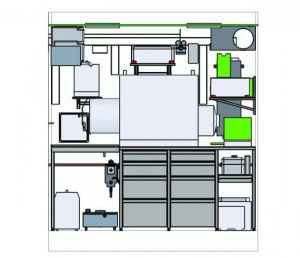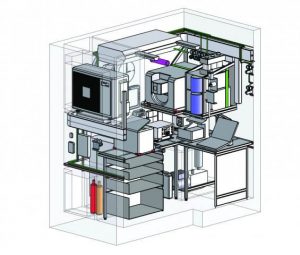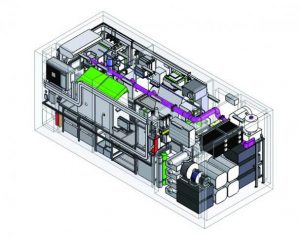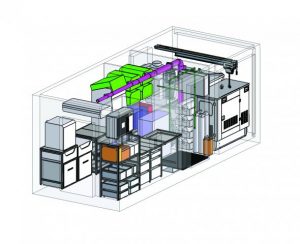Mobilné CBRN laboratóriá
MHELMOBILE HYGIENIC EPIDEMIOLOGICAL LABORATORY – MHEL
ESCRIPTION OF MOBILE HYGIENIC EPIDEMIOLOGICAL LABORATORY AND ITS COMPONENTS
- The container ISO-1C laboratory set comprises of a laboratory and a technological container. Laboratory container with high-level security includes an area with special biological, chemical and radiological detection and analytical instruments and equipment that consists of laboratory part and technological part with high-level of self-sufficiency. Equipped with an independent communication and control system. Technological container with a special area contains supporting technologies that supply energy for operation of the laboratory container.
- The laboratory set is transported to its required destination by a truck TATRA 815 270 R84 41 300 8×8.2 with a side lifter STEELBRO KL 300/61 and a container trailer. The laboratory set can be transported on regular roads, railways, ships or by air crafts.
- The laboratory is able to fulfil tasks in the vicinity of contaminated areas of immediate danger, including work in urban areas. It is suitable for work with the most dangerous types of biological and chemical contamination.
PURPOSE AND FUNCTIONS OF THE LABORATORY
- Quick quantitative and qualitative analysis of unknown biological pathogens, chemical and radionuclide contamination in delivered samples of suspicious material and environment from places of assumed biological and chemical attacks, on the level of preliminary and confirming identification, in compliance with AEP-10. Obtaining important information necessary for organizing effective and complex measures for biological, chemical and radiological protection. The range of identifiable toxic biological agents, toxic chemicals, industrial dangerous agents and middle-spectrum agents meets requirements of STANAG 4632.
- Supporting analyses, including quantitative identification of residual contamination in delivered samples of environment and samples taken from surfaces of checked materials, including determining the effectiveness of decontamination processes and checking the effectiveness of decontamination agents.
- Supporting analyses of water.
MAIN ALANYTICAL METHODS
BIOLOGICAL DIAGNOSTICS:
- Polymerase chain reaction- (PCR) in real time.
- Imunochromatography and EIA/ELISA applications.
- Optical and AFM microscopy.
Separating techniques are based on separation to magnetic phase, immuno-magnetic separation and standard physical-chemical separation processes.
CHEMICAL ANALYSES:
- Gas and liquid chromatography with mass spectrometry (GC/ MS(FID), HPLC/MS-MS(DAD).
- Infrared – Raman spectrometry (IR).
- X-ray fluorecsent spectrometry (XRF).
- Extraction spectrophotometry in ultra-violet and visible sphere (UV/VIS).
- Determination of chemical contamination presence by IMS method (ion mobility spectrometer) – Ion chromatography.
RADIOMETRY AND RADIONUCLIDE IDENTIFICATION:
- Identification of measurable α, β, γ, n, activity as well as field measurements of dose input, surface contamination and volume air contamination
- Radionuclide α, γ identification spectrometry.
- Analysis of molecular composition of materials containing radionuclides identified by ion chromatography (IC).
BASIC TIMES
- Time needed to prepare for sample analysis: up to 30 min
- Time needed to set up the laboratory: up to 1 hour.
- Time needed to prepare the laboratory for work: 1 – 4 hours, dependent on the task.
- Time needed to identify an unknown substance of biological, chemical and radiological nature – preliminary/confirming: 2 – 6 – 24 hours.
- Analytical control capacity: 40 samples in 12 hours.
- Time of continual operation without new supplies of operation materials or equipment: 4-6 days.




